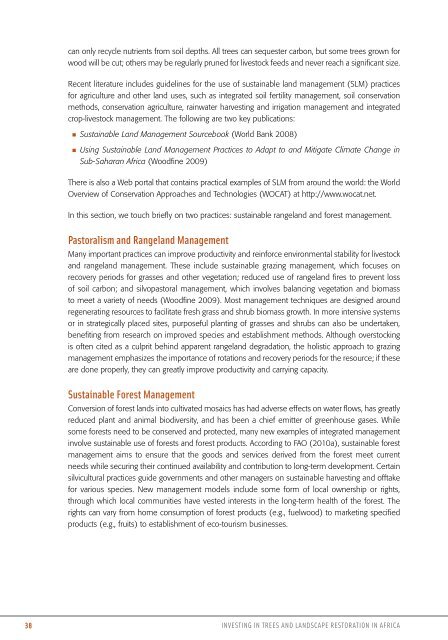INVESTING IN TREES AND LANDSCAPE ... - PROFOR
INVESTING IN TREES AND LANDSCAPE ... - PROFOR
INVESTING IN TREES AND LANDSCAPE ... - PROFOR
You also want an ePaper? Increase the reach of your titles
YUMPU automatically turns print PDFs into web optimized ePapers that Google loves.
can only recycle nutrients from soil depths. All trees can sequester carbon, but some trees grown for<br />
wood will be cut; others may be regularly pruned for livestock feeds and never reach a significant size.<br />
Recent literature includes guidelines for the use of sustainable land management (SLM) practices<br />
for agriculture and other land uses, such as integrated soil fertility management, soil conservation<br />
methods, conservation agriculture, rainwater harvesting and irrigation management and integrated<br />
crop-livestock management. The following are two key publications:<br />
• Sustainable Land Management Sourcebook (World Bank 2008)<br />
• Using Sustainable Land Management Practices to Adapt to and Mitigate Climate Change in<br />
Sub-Saharan Africa (Woodfine 2009)<br />
There is also a Web portal that contains practical examples of SLM from around the world: the World<br />
Overview of Conservation Approaches and Technologies (WOCAT) at http://www.wocat.net.<br />
In this section, we touch briefly on two practices: sustainable rangeland and forest management.<br />
Pastoralism and Rangeland Management<br />
Many important practices can improve productivity and reinforce environmental stability for livestock<br />
and rangeland management. These include sustainable grazing management, which focuses on<br />
recovery periods for grasses and other vegetation; reduced use of rangeland fires to prevent loss<br />
of soil carbon; and silvopastoral management, which involves balancing vegetation and biomass<br />
to meet a variety of needs (Woodfine 2009). Most management techniques are designed around<br />
regenerating resources to facilitate fresh grass and shrub biomass growth. In more intensive systems<br />
or in strategically placed sites, purposeful planting of grasses and shrubs can also be undertaken,<br />
benefiting from research on improved species and establishment methods. Although overstocking<br />
is often cited as a culprit behind apparent rangeland degradation, the holistic approach to grazing<br />
management emphasizes the importance of rotations and recovery periods for the resource; if these<br />
are done properly, they can greatly improve productivity and carrying capacity.<br />
Sustainable Forest Management<br />
Conversion of forest lands into cultivated mosaics has had adverse effects on water flows, has greatly<br />
reduced plant and animal biodiversity, and has been a chief emitter of greenhouse gases. While<br />
some forests need to be conserved and protected, many new examples of integrated management<br />
involve sustainable use of forests and forest products. According to FAO (2010a), sustainable forest<br />
management aims to ensure that the goods and services derived from the forest meet current<br />
needs while securing their continued availability and contribution to long-term development. Certain<br />
silvicultural practices guide governments and other managers on sustainable harvesting and offtake<br />
for various species. New management models include some form of local ownership or rights,<br />
through which local communities have vested interests in the long-term health of the forest. The<br />
rights can vary from home consumption of forest products (e.g., fuelwood) to marketing specified<br />
products (e.g., fruits) to establishment of eco-tourism businesses.<br />
38 <strong><strong>IN</strong>VEST<strong>IN</strong>G</strong> <strong>IN</strong> <strong>TREES</strong> <strong>AND</strong> L<strong>AND</strong>SCAPE RESTORATION <strong>IN</strong> AFRICA

















